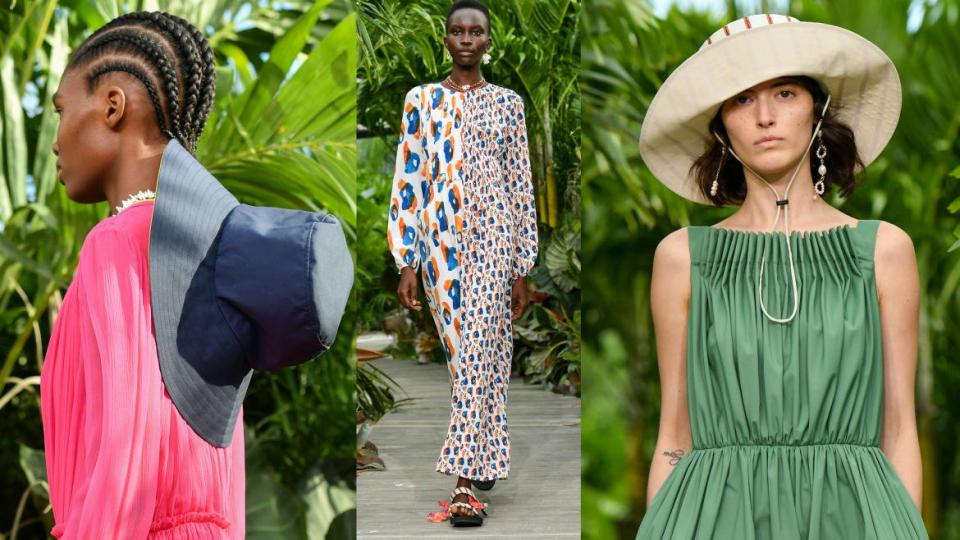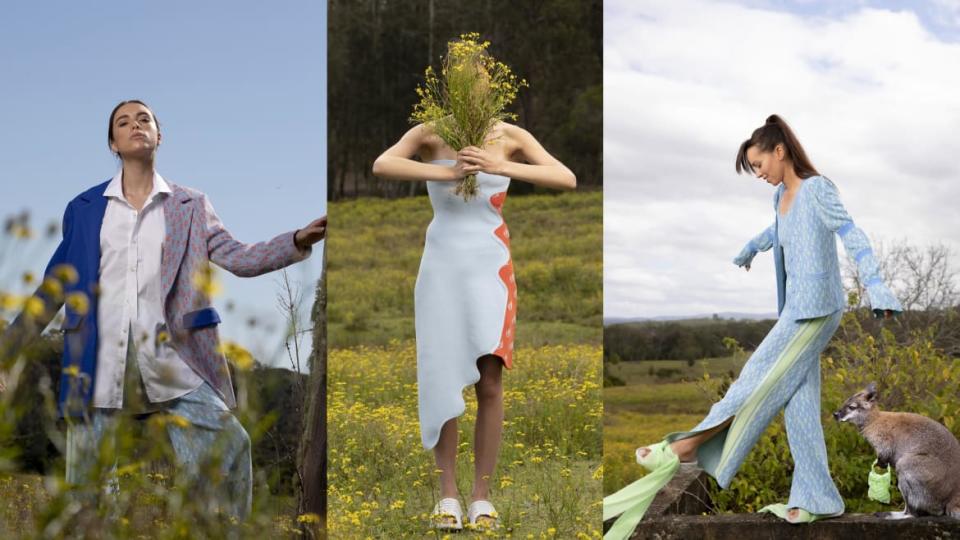Jason Wu, Carolina Herrera, and More: New York Fashion Week Brings the Front Row To Your Laptop


Jason Wu
Jason Wu Thank you, Jason Wu, because even if most of us were not watching in Tulum (where Wu married his husband in 2016), it certainly felt as if we could be.
The very first show of New York Fashion Week took place on the roof at Spring Studios, fronds blowing in the wind, the few guests sitting at appropriate social distances. The clothes, like the show, felt more relaxed than usual. The models walked along a winding, sandy-looking path, decked in the kinds of clothes it might be fun to have in your shipwreck suitcase: colors bold and muted, soft, stripes and bold, block color. Long, flowing dresses, attractive prints, easy-breezy, nothing tight. A few blazers. No high heels. Instead, the models walked in lovely, tatty-looking sandals with tassels on them.
Fashion Weeks Are Set for a Radical Makeover, and Not Just Because of COVID-19
At the end of the show, the camera tracked up and dwelt on New York’s rooftops, and then swung towards One World Trade Center. Without commentary so near to the 19th anniversary of the September 11 attacks, it was oddly profound, a note of defiance and still standing. It may mostly be seen on computer screens these next few days, but NYFW—whatever these strange times—wants you to know it is still here. Tim Teeman

Harlem's Fashion Row
Harlem’s Fashion Row
On the first night of New York Fashion Week, Harlem’s Fashion Row, the platform for multicultural designers, celebrated its 13th annual gala. The show took a virtual approach this year, featuring designers Richfresh, Kimberly Goldson, and Kristian Loren. This year’s theme was “Black is the new Black,” based on the notion that the Black talent that has always been in the industry must now shine unapologetically.
Richfresh’s models stormed the virtual runway in geometric prints, bright shades of orange, blue, green, and pink in luxury fabrications including silk and wool. The signature statement of his line was the track stripe details on pieces ranging from dresses to handbags. He also introduced tailored suiting for women. Most of the pieces focused on luxury sportswear, a smart move in a growing athleisure market.
Richfresh was followed by Kristian Loren whose clothes were a combination of '70s and '90s flare. The muses for her collection were rapper Foxy Brown and the title character of the film Cleopatra Jones. Sequins and sheer pants gave a feeling of both glitz and sex appeal. The color scheme included desert sunset orange, rust brown, and magenta. Loren’s theme of Black female empowerment continued on with the final designer of the night, Kimberly Goldson.
Goldson was inspired by Black women’s hair for her latest collection. Graphic t-shirts featured technical fabrications to create 3-D pop outs of Black women’s hairstyles ranging from natural afros to goddess braids. Goldson said she wanted to create something Black women could be proud of, and with Black women’s hair going beyond a personal issue to being a political one, she managed to also make it into a fashion statement. Kristopher Fraser
Marchesa
Though Georgina Chapman took Marchesa to a very posh underground after her husband Harvey Weinstein was accused and later convicted of criminal sex acts in 2017, the label never died. Marchesa’s presence at NYFW may be dimmed, but the brand did snap up a Monday morning slot on the official calendar, which Chapman used to drop a spring/summer look book.
The 26 gowns, shot by photographer Haifa Wøhlers Olsen, are fit for a reality that perhaps no one but Georgina Chapman lives in. No pesky global pandemic or collective sense that the end times are imminent can dull Chapman's shine, or deter her from the usual amount of feathered bodices and crystal embellishment. Her pieces have always skewed unabashedly glamorous.
Now, anyone with a reason to wear the dresses would be considered a coronavirus villain—a well-heeled GOP donor attending an indoor fundraiser, perhaps, or a mother-of-the-bride hell-bent on holding a 300-person wedding that flaunts stay-at-home orders. With their retro empire waists and sweeping silhouettes, these gowns clearly nod to Jazz Age excess. And we all know what came after that era. Looking at these jeweled behemoths, you cannot help but brace for a crash. Alaina Demopoulos

PH5
PH5
For its non-runway format, the knitwear brand PH5 used Aboriginal women to model their spring/summer 2021 collection, with a short video about the practice of cultural burning in Australia, and cultural identity more generally. Beautifully shot, the clothes were patterned with the swirls of white smoke that were described in the video, jumpsuits patterned with trees, and other items in earthy brown and green.
PH5 said the season had begun with the Australian bushfires. “With everything happening in the world, this season we share our platform with a group of Indigenous Australian women working with (the Indigenous-led) Firesticks Alliance to protect, conserve and enhance cultural and natural values of people and Country through cultural fire and land management practices.” A very different kind of burning, another caption made clear the “thoughts” of PH5 were those affected by the fires burning on the west coast. TT

Carolina Herrera talks to Wes Gordon
Carolina Herrera
I’m sure Carolina Herrera’s spring/summer collection is fabulous. But all I care about is her living room. In lieu of a runway this season, the designer sat down with her brand's creative director, Wes Gordon, for an "intimate conversation" inside her Manhattan townhouse. Predictably for a woman who lives and breathes taste and is beloved by First Ladies from Jackie Onassis to Michelle Obama (plus both Melania and Ivanka Trump), her home is a visual treat.
Porcelain chickens spruce up a mammoth fireplace, and the striped wallpaper matches a preppy couch. Herrera and Gordon both still worship glamour, in spite of the pandemic. The 81-year-old designer, whose namesake line turns 40 next year, said she does not own sweatpants. She regaled Gordon with tales of her early days in '80s New York. One highlight: Studio 54 co-owner Steve Rubell was almost kicked out of her first runway show because he wasn’t wearing a tie. (He ran next door to Bergdorf’s to pick one up for the occasion.)
Though the 15-minute conversation was clearly vetted by a public relations exec to make sure Herrera and Gordon brought up her numerous makeup products from time to time, there were some moments of spontaneity, or at least the rich person version of it. According to Herrera, Legendary Vogue editor Diana Vreeland called her initial pitch for designing womenswear "boring." At one point, a breathless Gordon said, “I only want to be surrounded by things that are beautiful and items that tell a story." Same here, now that I think about it. AD
Jonathan Simkhai
For the first time in a decade, the designer Jonathan Simkhai has not held a runway show or presentation at NYFW. Instead, he opted for a short promotional video—a slick ad, basically—to showcase his fall collection. In the short film, models walked through empty catwalks, weaving around seats that would otherwise be filled by guests.
The women wear suits and large overcoats and wield their clothing like armor. Their hands are thrust in their pockets and they move at a slow, measured gait. Simkhai’s show notes say that the line is “designed for everyone,” though his dresses can cost $900. His clothes might be sturdy and project a nebulous kind of empowerment, but there is not much necessarily new or daring here. AD
CFDA Awards
The CFDA Awards were cancelled back in June; Tom Ford put on his oversized sunglasses to film a video finally announcing this year’s winners. As the CFDA put in a press release, the lineup of winners “[represents] the most diverse group of recipients in the 39-year history of the awards.”
All of the American designers are first-time awardees. Gabriela Hearst won for American Womenswear Designer of the Year; Kerby Jean-Raymond of Pyer Moss won American Menswear Designer of the Year, Telfar Clemens of Telfar won American Accessories Designer of the Year, Christopher John Rogers won American Emerging Designer of the Year, Pierpaolo Piccioli of Valentino won International Women’s Designer of the Year, and Kim Jones of Dior won International Men’s Designer of the Year. AD
Get our top stories in your inbox every day. Sign up now!
Daily Beast Membership: Beast Inside goes deeper on the stories that matter to you. Learn more.


